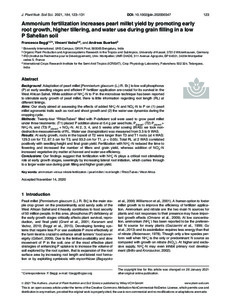| dc.date.accessioned | 2021-03-18T09:40:30Z | |
| dc.date.available | 2021-03-18T09:40:30Z | |
| dc.date.issued | 2020-12-01 | |
| dc.identifier | doi:10.17170/kobra-202102193323 | |
| dc.identifier.uri | http://hdl.handle.net/123456789/12648 | |
| dc.description.sponsorship | Gefördert im Rahmen des Projekts DEAL | ger |
| dc.language.iso | eng | eng |
| dc.rights | Attribution-NonCommercial-NoDerivatives 4.0 International | * |
| dc.rights.uri | http://creativecommons.org/licenses/by-nc-nd/4.0/ | * |
| dc.subject | ammonium versus nitrate fertilization | eng |
| dc.subject | pearl millet | eng |
| dc.subject | root length | eng |
| dc.subject | Rhizo Tubes | eng |
| dc.subject | West Africa | eng |
| dc.subject.ddc | 570 | |
| dc.subject.ddc | 580 | |
| dc.title | Ammonium fertilization increases pearl millet yield by promoting early root growth, higher tillering, and water use during grain filling in a low P Sahelian soil | eng |
| dc.type | Aufsatz | |
| dcterms.abstract | Background: Adaptation of pearl millet [Pennisetum glaucum (L.) R. Br.] to low soil phosphorus (P) at early seedling stages and efficient P fertilizer application are crucial for its survival in the West African Sahel. While addition of NH+4-N to P in the microdose technique has been reported to stimulate early growth of pearl millet, there is little information regarding root length (RL) at different timings.
Aims: Our study aimed at assessing the effects of added NH+4-N and NO−3-Nto P on (1) pearl millet agronomic traits such as root and shoot growth and (2) the water use dynamics during the cropping cycle.
Methods: Twenty‐four “RhizoTubes” filled with P‐deficient soil were used to grow pearl millet under three treatments: (T1) placed P addition alone at 0.4 g per seed hole, Pplaced, (T2) Pplaced + NH+4-N, and (T3) Pplaced + NO−3-N. At 2, 3, 4, and 5 weeks after sowing (WAS) we took non‐destructive measurements of RL. Water use (transpiration) was measured from 3.5 to 9 WAS.
Results: At early growth, roots in the topsoil of T2 were longer than T3 and T1 roots (at 4 WAS: 129.3 cm for T2, 87.5 cm for T3, and 93.3 cm for T1, p < 0.05). Total RL at 2 WAS correlated positively with seedling height and final grain yield. Fertilization with NH+4-N reduced the time to flowering and increased the number of tillers and grain yield, whereas addition of NO−3-N increased vegetative dry matter at harvest and water use efficiency.
Conclusions: Our findings suggest that fertilization with NH+4-N plays a critical root stimulating role at early growth stages, seemingly by increasing lateral root initiation, which carries through to a larger water use during grain filling and higher grain yield. | eng |
| dcterms.accessRights | open access | |
| dcterms.creator | Beggi, Francesca | |
| dcterms.creator | Vadez, Vincent | |
| dcterms.creator | Bürkert, Andreas | |
| dc.relation.doi | doi:10.1002/jpln.202000347 | |
| dc.subject.swd | Westafrika | ger |
| dc.subject.swd | Düngung | ger |
| dc.subject.swd | Ammoniumverbindungen | ger |
| dc.subject.swd | Nitration | ger |
| dc.subject.swd | Perlhirse | ger |
| dc.subject.swd | Wurzel | ger |
| dc.subject.swd | Wassernutzung | ger |
| dc.type.version | publishedVersion | |
| dcterms.source.identifier | EISSN 1522-2624 | |
| dcterms.source.issue | Issue 1 | |
| dcterms.source.journal | Journal of Plant Nutrition and Soil Science (JPNSS) | eng |
| dcterms.source.pageinfo | 123-131 | |
| dcterms.source.volume | Volume 184 | |
| kup.iskup | false | |


